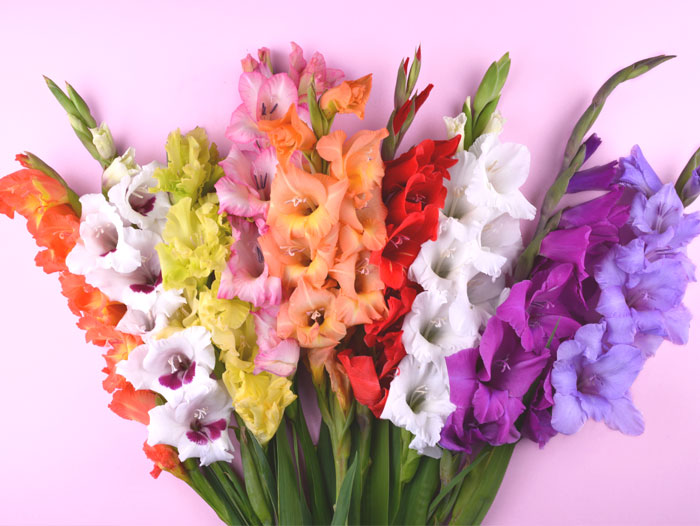Gladiolus: the Summer Bulb of the Year
April 6, 2020 | 4 min to read

The Gladiolus is such a popular summer bulb that flower bulb specialists have appointed it “Summer Bulb of the Year”. These plants introduce color by producing tall spikes covered with flowers and surrounded by sword-shaped leaves. Their rewarding flowers provide unprecedented enjoyment.
The sword lily
According to botanists, there are around 300 different gladiolus species that come originally from Africa. There, they occur as wild plants growing in their natural environment. They have been cultivated ever since 1941 so anyone can now enjoy them in their gardens. Their botanical name, “Gladiolus” – is the diminutive for the Latin word, Gladius, which means “sword”. Their sword-shaped leaves and the meaning of their botanical name has led to their common name: sword lilies.
A corm
Gladioli can be recognized by their tall, sturdy, upright stems. Both sides of this stem are covered with flowers that can be almost any color of the rainbow. And they can range from pastels to vivid eye-catching hues. Did you know that a gladiolus isn’t a true bulb, but rather what’s known as a corm? Unlike true bulbs that store their nutrients in layers of scales, corms use their solid fleshy roots as an underground storage organ.
Groups
Since there are so many different gladioli, there are two classified groups: the large-flowered and the small-flowered varieties.
The large-flowered group contains more varieties than the small-flowered one. These are made up of hundreds of varieties in a wide range of colors and color combinations. In general, they are taller than three feet. These varieties include:
- Butterfly gladioli: their flowers are delicate and their colors contrast with the rest of the plant which give them the appearance of butterflies. They are characterized by alternately arranged flowers, made up of tightly packed petals. The inner petals often display a color different than the outer ones.
- Primulinus gladioli: the varieties in this group were developed from the yellow Gladiolus primulinus. The plant itself has a narrow silhouette and its uppermost petals cover the stamens beneath.
Small-flowering gladioli produce smaller flowers and are not as tall. They are subdivided into:
- Gladiolus colvillii ‘Alba’: this is one of the oldest small-flowered gladioli varieties and is a cross between two species: G. tristis and G. cardinalis.
- Gladiolus nanus: this gladiolus is known for its gracefulness. Its spikes are no taller than 24 to 28 inches. This has led to this gladiolus being referred to as a ‘dwarf gladiolus’.
- Gladiolus tubergenii: this one, named for the plant breeder Van Tubergen, is one of the earliest-flowering kinds.
Planting and care
Gladioli need plenty of light, so plant them in a sunny location in the garden. They combine well with other summer bulbs, such as dahlias and foxtail lilies (Eremurus) as well as with perennials and ornamental grasses. They can be planted from mid-April until the end of May. Arrange them in small groups of 3-5 corms at a depth of about 4 inches. Make sure that the pointed end is on top. After planting, drench the soil to get them off to a good start, and keep watering during dry weather.
Interesting little facts
- If you want to enjoy gladioli indoors, they make perfect cut flowers. Once one or two flowers have opened, cut a few stems and place them in a vase.
- Gladioli can reach a height of 36 – 48 inches. Outdoors, stake them to prevent a heavy downpour or gusts of wind from blowing them over.
- Did you know that gladioli will also grow nicely in pots? The shorter varieties are especially well-suited for this purpose.
- When buying them, select large firm corms and avoid any soft ones or corms that are already sprouting since these are diseased.
- If you would like to know more about flower bulbs, this is available at www.flowerbulbs.com.
About iBulb
iBulb is the promotional agency for the flower bulb sector. iBulb promotes the use of flower bulbs, bulb flowers and bulbs in pots by means of worldwide PR activities and advertising campaigns. More information is available at www.ibulb.org.
